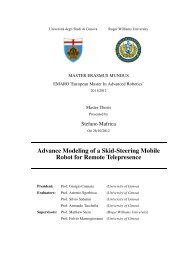SECCM Assessment Plan - Roger Williams University
SECCM Assessment Plan - Roger Williams University
SECCM Assessment Plan - Roger Williams University
Create successful ePaper yourself
Turn your PDF publications into a flip-book with our unique Google optimized e-Paper software.
Senior Capstone Sequence<br />
The hallmark of the computer science curriculum is a two-semester senior capstone experience that<br />
immerses students in a real-world project. Every course in the curriculum provides some aspect of<br />
the underlying knowledge students require to meet a real-world computing problem. Students are<br />
given the opportunity to put that knowledge to use in solving open-ended problems for clients as part<br />
of COMSC490/492 Senior Design I&II. Students form three or four-person teams (with students of<br />
other disciplines if possible) and meet their respective client to begin the process of establishing a set<br />
of requirements. Using an iterative approach, students analyze the needs of the client and balance<br />
them against available resources; including the experience each student brings to the team. Over the<br />
course of two semesters students are exposed to almost all aspects of total system development<br />
from problem statement through client delivery. Tentative solutions are subject to numerous realistic<br />
constraints involving performance, quality, documentation standards and target system integration<br />
requirements.<br />
As students refine their design and implementation, they are expected to produce functional<br />
prototypes. Student teams conduct frequent review presentations for their client detailing the<br />
progress, risks and mitigation strategies and future events leading towards successful completion of<br />
the project. The primary goal of the course includes the delivery of a successful project to the client<br />
by the end of the second semester course. Other critical goals are the use of a systematic process to<br />
bring a project to completion as well as the experiences accrued through reliance on team members<br />
other team members.<br />
The types of projects that the teams undertake are similar to those commonly found in industry. They<br />
are characterized by reliance on team members as well as the importance of communication skills in<br />
dealing with the clients. Projects completed over the most recent years included remote programming<br />
of industrial robots, data fusion and visualization, web-based surveys, and autonomous maze solving<br />
robotic mice. Several projects have been used as prototypes for further study as commercialized<br />
enhancements of their current product lines. Students have presented their work at national<br />
conferences, regional competitions, and the <strong>Roger</strong> <strong>Williams</strong> <strong>University</strong> Senior Showcase.<br />
Other objectives for the two-semester Computer Science Capstone Sequence include the following:<br />
1) Understand how a computer information system must fit into an organization or be part a<br />
component of a larger system.<br />
2) Understand the importance of a systematic approach in software system production<br />
3) Know how to conduct requirement analysis and develop a software system using object<br />
oriented and conventional methodologies.<br />
4) Develop and execute an implementation strategy resulting in the delivery of a satisfactory<br />
artifact to a real-world client.<br />
5) Effectively use computer-aided tools to assist in conducting the requirement analysis, design,<br />
implementation, testing and delivery of a software system<br />
6) Demonstrate the effective integration of the aforementioned skills (as well as skills developed<br />
in other classes) by actively participating as a team member in developing a software system<br />
for an open-ended problem with a real client<br />
Computer Science Program Objectives<br />
The program objectives of the Computer Science Program at <strong>Roger</strong> <strong>Williams</strong> <strong>University</strong> are listed<br />
below in Table 3.9, RWU Computer Science Program Educational Objectives. These objectives are<br />
published in the <strong>Roger</strong> <strong>Williams</strong> <strong>University</strong> Undergraduate Catalog, on the School of Engineering,<br />
Computing and Construction Management’s web site and in a number of promotional materials.<br />
52
















